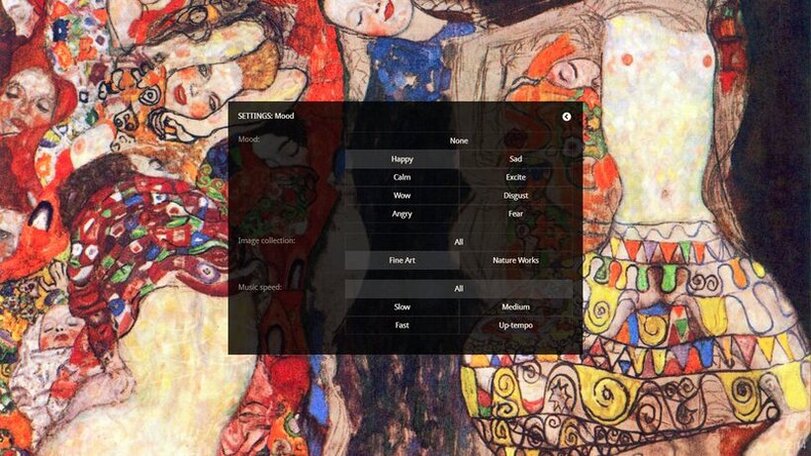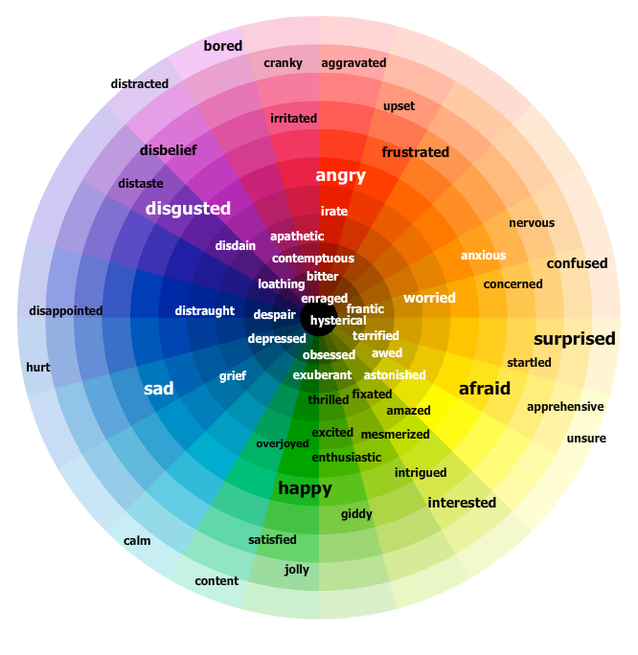Stream Art and Music by Mood Using AI
It is claimed that art is the most potent form of emotional communication.
An example is to observe paintings or photographs of bright, open landscapes that often evoke a feeling of beauty, relaxation or happiness. Similarly, visual images that are dark and/or obscure typically elicit emotions of anxiety and fear.
Totally unique and groundbreaking, ArtPlayer can display artworks and nature pictures based on your selected mood setting: Happy, Sad, Calm, Excited, Awed, Disgusted, Angry or Afraid. The mood selection is done using image recognition technology based on artificial intelligence and machine learning algorithms analyzing brightness, contrast, edges, color, texture, layout, shape etc. The background music will also adapt to the emotional expression of the images and thus reinforce the chosen mood.
ArtPlayer mood art and music control can be used to edutainment in museums and libraries or to generate an appropriate ambience in locations such as hotels and restaurants, but also for improving work environment in companies as well as patient surroundings in hospitals and nursing homes.
For example, ArtPlayer can be scheduled in a digital signage playlist to play Happy or even Excited art and music during the day creating an active or energetic mood, while playing Calming art and music in the morning and evening creating a relaxing atmosphere.
Contact us for free 30 days trial, book an online demo or become a reseller etc.
Workplace
According to psychology professors Dr. Craig Knight and Dr. S. Alexander Haslam, employees work approximately 15 percent faster in an office with art than those in a lean office. With Dr. Knight's words: “If you enrich a space people feel much happier and work better; a very good way of doing this is by using art.”
A survey confirms the results conducted by the Business Committee for the Arts and the International Association of Professional Art Advisors of more than 800 employees of 32 companies that displayed art in the workplace, 94 percent of respondents agreed that art enhanced the work environment; 78 percent said that it contributed to reduced stress; 64 percent saw increased creativity and productivity; and 67 percent said that it enhanced morale. These statistics demonstrate the potential return on investment concerning corporate art and visual design.
When designing art and interior solutions, companies should keep in mind the psychological properties of colors that can affect behavior. Specific colors can evoke similar emotional and behavioral responses in people. Research from the University of Colombia, for example, shows that blue and green make employees feel calm and relaxed, which can positively impact productivity.
Retail
The retail sector, meanwhile, benefits from a more excited and adventurous approach to color. Most colors work well in retail spaces except for blue or grey; colors that stimulate a cautious attitude and might inhibit customers to spend their money.
Hospitality
Also, according to color psychologist Angela Wright, the hospitality industry should opt for interior design solutions with warm and happy colors: “Orange is the best color to promote the hospitality industry – it makes you hungry, it is sensual and it is the best fun color.”
Healthcare
As a decoration and mood regulation tool for the healthcare industry or even digital medicine for patient therapy and healing, ArtPlayer is evidence-based designed for positive distraction by creating calm or joy through meditative and trance-like static or moving art.
The study “Impact of Visual Art on Waiting Behavior in the Emergency Department” by PhD Upali Nanda and The Center for Health Design concludes that a visual art intervention on screen, that is carefully selected based on best available evidence, can not only impact patient (and visitor) behavior, but also the overall healthcare experience, including:
Also, the study points out that regular TV programs are an "ineffective" distraction and TV as a source of explicit distraction did not lead to shorter perceived wait times. In fact, people viewing TV perceived the wait time as longer.
In another study “Introducing Positive Distraction in a Clinic Waiting Room” by Qiwen Luo about 80% of the comments reported that they disliked the TV news, finding it to be stressful, sad and noisy.
A study by Jacobs and Suess of the effects of red, yellow, green and blue projected on to a large screen showed higher state-anxiety scores with red and yellow than with blue and green. A similar study by Jacobs and Hustmyer monitoring physiological variables showed greater increases in heart rate and respiratory rate with red and yellow than with blue and green. It was concluded that color may be one of the reasons why patients prefer paintings depicting nature scenes, since these are often dominated by blue and green.
According to psychology professors Dr. Craig Knight and Dr. S. Alexander Haslam, employees work approximately 15 percent faster in an office with art than those in a lean office. With Dr. Knight's words: “If you enrich a space people feel much happier and work better; a very good way of doing this is by using art.”
A survey confirms the results conducted by the Business Committee for the Arts and the International Association of Professional Art Advisors of more than 800 employees of 32 companies that displayed art in the workplace, 94 percent of respondents agreed that art enhanced the work environment; 78 percent said that it contributed to reduced stress; 64 percent saw increased creativity and productivity; and 67 percent said that it enhanced morale. These statistics demonstrate the potential return on investment concerning corporate art and visual design.
When designing art and interior solutions, companies should keep in mind the psychological properties of colors that can affect behavior. Specific colors can evoke similar emotional and behavioral responses in people. Research from the University of Colombia, for example, shows that blue and green make employees feel calm and relaxed, which can positively impact productivity.
Retail
The retail sector, meanwhile, benefits from a more excited and adventurous approach to color. Most colors work well in retail spaces except for blue or grey; colors that stimulate a cautious attitude and might inhibit customers to spend their money.
Hospitality
Also, according to color psychologist Angela Wright, the hospitality industry should opt for interior design solutions with warm and happy colors: “Orange is the best color to promote the hospitality industry – it makes you hungry, it is sensual and it is the best fun color.”
Healthcare
As a decoration and mood regulation tool for the healthcare industry or even digital medicine for patient therapy and healing, ArtPlayer is evidence-based designed for positive distraction by creating calm or joy through meditative and trance-like static or moving art.
The study “Impact of Visual Art on Waiting Behavior in the Emergency Department” by PhD Upali Nanda and The Center for Health Design concludes that a visual art intervention on screen, that is carefully selected based on best available evidence, can not only impact patient (and visitor) behavior, but also the overall healthcare experience, including:
- Reduce perceived waiting time which is more important of patient satisfaction than actual waiting time
- Reduce restless behavior by giving patients a positive and calming art distraction to look at while they are in the waiting room
- Decrease people watching, i.e. people staring at other people which can be stressful
- Increase socialization by creating a positive mood with art which can impact social support between patients and caregivers
- Decrease front-desk queries which can result in a decrease in staff time and staff stress
- Reduce noise level due to reduction in patient stress
Also, the study points out that regular TV programs are an "ineffective" distraction and TV as a source of explicit distraction did not lead to shorter perceived wait times. In fact, people viewing TV perceived the wait time as longer.
In another study “Introducing Positive Distraction in a Clinic Waiting Room” by Qiwen Luo about 80% of the comments reported that they disliked the TV news, finding it to be stressful, sad and noisy.
A study by Jacobs and Suess of the effects of red, yellow, green and blue projected on to a large screen showed higher state-anxiety scores with red and yellow than with blue and green. A similar study by Jacobs and Hustmyer monitoring physiological variables showed greater increases in heart rate and respiratory rate with red and yellow than with blue and green. It was concluded that color may be one of the reasons why patients prefer paintings depicting nature scenes, since these are often dominated by blue and green.



